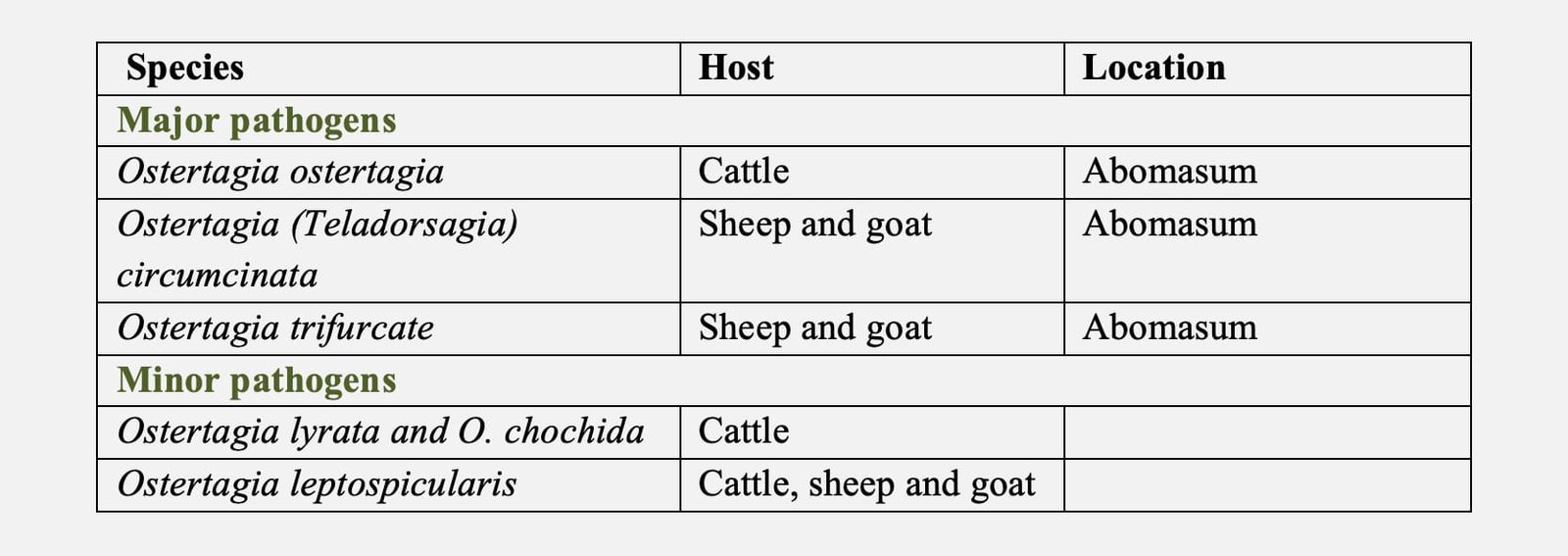TABLE OF CONTENTS
Ostertagiasis
Ostertagiasis is a major cause of parasitic gastritis in ruminants in temperate areas of the world.

The adult worms are slender reddish-brown up to l.0cm long, occurring on the surface of the abomasal mucosa and are only visible on close inspection. The larval stages occur in the gastric glands and can only be seen microscopically following processing of the gastric mucosa.
Distribution: Worldwide, Ostertagia is especially important in temperate climate and in subtropical regions with winter rainfall.
Ostertagia ostertagia
Ostertagia ostertagi is the most common cause of parasitic gastritis in cattle. The disease often simply known as ostertagiasis.
It is characterized by weight loss, diarrhoea and typically affects young cattle during first grazing season, although sporadic individual cases in adults are reported.
Life cycle (Direct)
- The eggs are passed in the faeces and develop into infective L3 larva within the faecal pat under optimal condition.
- The L3 Larvae remain in the faecal pat until moistened by rain. The L3 larvae migrate from faeces onto herbage.
- After ingestion, the L3 exsheaths in the rumen and further development takes place in the lumen of abomasal gland.
- Two parasitic moults occur before the L5 emerge from gland around 18 days after infection.
- For completion of entire life cycle takes three weeks. But under certain circumstances many of the ingested L4 become arrested in development at the early fourth larval stage (EL,) for periods of up to six months.
Pathogenesis
- The developing parasites cause a reduction in the functional gastric gland mass responsible for the production of the highly acidic proteolytic gastric juice; in particular, the parietal cells, which produce hydrochloric acid, are replaced by rapidly dividing, undifferentiated, non-acid-secreting cells.
- Initially, these cellular changes occur in the parasitized gland, but as it becomes distended by the growing worm which increases from 1.3-8.0mm in length, these changes spread to the surrounding non parasitized glands, results in thickened hyperplastic gastric mucosa.
- This results in leakage of pepsinogen into the circulation leading to elevated level of plasma pepsinogen and the loss of plasma proteins into the gut lumen eventually leading to hypoalbuminemia.
Clinical manifestation
It occur in two form:
Type I
- It is usually seen in calves grazed intensively during their first grazing season. Infection usually occurs in mid July onwards (July-October month).
- Persistent profuse greenish watery diarrhoea.
- loss of weight.
- Morbidity is high and mortality low.
Type II
- The disease occur in yearling and in late winter or spring following first grazing season results from maturation of larva ingested during the previous autumn (arrested development at L4 stage).
- Intermittent profuse watery diarrhoea, anorexia, thirst and loss of weight.
- Hind quarters highly soiled with faeces.
- Hypoalbuminemia.
- Submandibular edema.
- Morbidity is low and mortality rate is very high.
Treatment
- Benzimidazole (Albendazole, Fenbendazole or Oxfendazole), Probenzimidazole (febental, netobiomin, and thiophnate), Levamisole or ivermectin and milbemectins are effective against immature and mature adult worms.
Diagnosis
- Base on clinical signs.
- Seasonal occurrence.
- Grazing history.
- Faecal egg count.
- Increased level of plasma pepsinogen (Tyrosine) > 3.0 IU/L (Normal 1.0 IU/L).
- Post mortem examination-presence of slender small red colour worms on abomasal mucosal surface.
Control
- Limiting exposure to infection by grazing on new pasture.
- Prophylactic antihelmintic treatment.
- Rotational grazing of young and adult stock- It involves continuous rotation of each paddock, in which susceptible young calves graze ahead of immune adults.
Ovine and Caprine Ostertagiosis
Pathogenesis, clinical signs and treatment of Ovine and caprine ostertagiosis is similar to Ostertagiasis in cattle (Ostertagia ostertagia).

